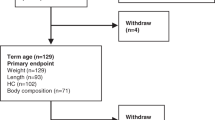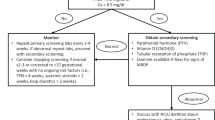Abstract
Objective:
To study the possible influences of amino acid (AA) intakes on growth and bone status in preterms.
Study Design:
Newborns, weighing <1250 g, received standard (S) or higher (H) parenteral AA intakes (3 or 4 g kg−1 per day). Anthropometry, biochemistry and quantitative ultrasound (metacarpus bone transmission time (mcBTT), in μs) were measured prospectively.
Result:
A total of 55 patients in group S and 60 in group H were studied. Significantly better growth rate was found in the H group during the study without signs of intolerance. We found a significant decrease in mcBTT from birth to 21 days in the H group; nonetheless, mcBTT at 36 weeks of gestational age significantly positively correlated with early AA and energy intakes. A significant positive correlation between mcBTT and lower limb length (LLL) at 21 days was found.
Conclusion:
Early higher AA intakes improved growth without short-term AA intolerance. Nutritional parameters could influence bone growth. LLL was the anthropometric parameter that best correlated to bone status.
This is a preview of subscription content, access via your institution
Access options
Subscribe to this journal
Receive 12 print issues and online access
$259.00 per year
only $21.58 per issue
Buy this article
- Purchase on Springer Link
- Instant access to full article PDF
Prices may be subject to local taxes which are calculated during checkout
Similar content being viewed by others
References
American Academy of Pediatrics. Nutritional needs of the preterm infant. In: Kleinman RE (ed) Pediatric Nutrition Handbook. 36, 5th edn American Academy of Pediatrics: Elk Grove, IL, 2004, pp 23–54.
Altuncu E, Akman I, Yurdakul Z, Ozdoğan T, Solakoğlu M, Selim N et al. Quantitative ultrasound and biochemical parameters for the assessment of osteopenia in preterm infants. J Matern Fetal Neonatal Med 2007; 20 (5): 401–405.
McDevitt H, Ahmed SF . ultrasound assessment of bone health in the neonate. Neonatology 2007; 91 (1): 2–11.
De Curtis M, Vetrano G, Natale F, Rigo J . Proteine. In: De Curtis M, Carnielli V (eds) La nutrizione del neonato. Editeam Publ.: Ferrara, 2006, pp 163–174, 210.
Rauch F, Schoenau E . Skeletal development in premature infants: a review of bone physiology beyond nutritional aspects. Arch Dis Child Fetal Neonatal Ed 2002; 86 (2): F82–F85.
Van Goudoever JB, Colen T, Wattimena JL, Huijmans JG, Carnielli VP, Sauer PJ . Immediate commencement of amino acid supplementation in preterm infants: effect on serum amino acid concentrations and protein kinetics on the first day of life. J Pediatr 1995; 127 (3): 458–465.
Te Braake FW, van den Akker CH, Wattimena DJ, Huijmans JG, van Goudoever JB . Amino acid administration to premature infants directly after birth. J Pediatr 2005; 147 (4): 457–461.
Thureen PJ, Anderson AH, Baron KA, Melara DL, Hay Jr WW, Fennessey PV . Protein balance in the first week of life in ventilated neonates receiving parenteral nutrition. Am J Clin Nutr 1998; 68 (5): 1128–1135.
Thureen PJ . Early aggressive nutrition in the neonate. Pediatr Rev 1999; 20 (9): e45–e55.
Rivera Jr A, Bell EF, Bier DM . Effect of intravenous amino acids on protein metabolism of preterm infants during the first three days of life. Pediatr Res 1993; 33 (2): 106–111.
Van den Akker CH, te Braake FW, Schierbeek H, Rietveld T, Wattimena DJ, van Goudoever JB et al. Albumin synthesis in premature neonates is stimulated by parenterally administered amino acids during the first days of life. Am J Clin Nutr 2007; 86 (4): 1003–1008.
Geary C, Caskey M, Fonseca R, Malloy M . Decreased incidence of bronchopulmonary dysplasia after early management changes, including surfactant and nasal continuous positive airway pressure treatment at delivery, lowered oxygen saturation goals, and early amino acid administration: a historical cohort study. Pediatrics 2008; 121 (1): 89–96.
Geary CA, Fonseca RA, Caskey MA, Malloy MH . Improved growth and decreased morbidities in <1000 g neonates after early management changes. J Perinatol 2008; 28 (5): 347–353.
Olsen IE, Richardson DK, Schmid CH, Ausman LM, Dwyer JT . Intersite differences in weight growth velocity of extremely premature infants. Pediatrics 2002; 110 (6): 1125–1132.
Poindexter BB, Langer JC, Dusick AM, Ehrenkranz RA . Early provision of parenteral amino acids in extremely low birth weight infants: relation to growth and neurodevelopmental outcome. National Institute of Child Health and Human Development Neonatal Research Network. J Pediatr 2006; 148 (3): 300–305.
Thureen PJ, Melara D, Fennessey PV, Hay Jr WW . Effect of low versus high intravenous amino acid intake on very low birth weight infants in the early neonatal period. Pediatr Res 2003; 53 (1): 24–32.
Hay Jr WW . Strategies for feeding the preterm infant. Neonatology 2008; 94 (4): 245–254.
Berseth CL, Van Aerde JE, Gross S, Stolz SI, Harris CL, Hansen JW . Growth, efficacy, and safety of feeding an iron-fortified human milk fortifier. Pediatrics 2004; 114 (6): e699–e706.
Ogilvy-Stuart AL, Beardsall K . Management of hyperglycaemia in the preterm infant. Arch Dis Child Fetal Neonatal 2010; 95 (2): F126–F131.
Mercy J, Dillon B, Morris J, Emmerson AJ, Mughal MZ . Relationship of tibial speed of sound and lower limb length to nutrient intake in preterm infants. Arch Dis Child Fetal Neonatal 2007; 92 (5): F381–F385.
Ritschl E, Wehmeijer K, De Terlizzi F, Wipfler E, Cadossi R, Douma D et al. Assessment of skeletal development in preterm and term infants by quantitative ultrasound. Pediatr Res 2005; 58 (2): 341–346.
Van Goudoever JB . Amino acid metabolism and protein accretion. In: Thureen PJ, Hay WW, Jr (eds). Neonatal Nutrition and Metabolism. Cambridge University Press: New York, 2006, pp 115–121.
Pesce MA . Reference ranges for laboratory tests and procedures. In: Behrman RE, Kliegman RM, Jenson HB (eds) Nelson Textbook of Pediatrics. 18th edn Saunders: Philadelphia, 2007, pp 2949.
Porcelli Jr PJ, Sisk PM . Increased parenteral amino acid administration to extremely low-birth-weight infants during early postnatal life. J Pediatr Gastroenterol Nutr 2002; 34 (2): 174–179.
Maggio L, Cota F, Gallini F, Lauriola V, Zecca C, Romagnoli C . Effects of high versus standard early protein intake on growth of extremely low birth weight infants. J Pediatr Gastroenterol Nutr 2007; 44 (1): 124–129.
Clark RH, Chace DH, Spitzer AR . Effects of two different doses of amino acid supplementation on growth and blood amino acid levels in premature neonates admitted to the neonatal intensive care unit: a randomized, controlled trial. Pediatrics 2007; 120 (6): 1286–1296.
Ibrahim HM, Jeroudi MA, Baier RJ, Dhanireddy R, Krouskop RW . Aggressive early total parental nutrition in low-birth-weight infants. J Perinatol 2004; 24 (8): 482–486.
Battaglia FC, Meschia G . Fetal nutrition. Annu Rev Nutr 1988; 8: 43–61.
Jadhav P, Parimi PS, Kalhan SC . Parenteral amino acid and metabolic acidosis in premature infants. J Parenter Enteral Nutr 2007; 31 (4): 278–283.
Stephens BE, Walden RV, Gargus RA et al. First-week protein and energy intakes are associated with 18-month developmental outcomes in extremely low birth weight infants. Pediatrics 2009; 123 (5): 1337–1343.
Blanco CL, Gong AK, Schoolfield J, Green BK, Daniels W, Liechty EA et al. The impact of early and high amino acid supplementation on ELBW infants at two years. J Pediatr Gastroenterol Nutr 2012; e-pub ahead of print 4 January 2012; doi:10.1097/MPG.0b013e31824887a0.
Cetin I, Corbetta C, Sereni LP, Marconi AM, Bozzetti P, Pardi G et al. Umbilical amino acid concentrations in normal and growth-retarded fetuses sampled in utero by cordocentesis. Am J Obstet Gynecol 1990; 162 (1): 253–261.
Kalhoff H, Diekmann L, Rudloff S, Manz F . Renal excretion of calcium and phosphorus in premature infants with incipient late metabolic acidosis. J Pediatr Gastroenterol Nutr 2001; 33 (5): 565–569.
Balakrishnan M, Tucker R, Stephens BE, Bliss JM . Blood urea nitrogen and serum bicarbonate in extremely low birth weight infants receiving higher protein intake in the first week after birth. J Perinatol 2011; 31 (8): 535–539.
Tomlinson C, McDevitt H, Ahmed SF, White MP . Longitudinal changes in bone health as assessed by the speed of sound in very low birth weight preterm infants. J Pediatr 2006; 148 (4): 450–455.
Weiler HA, Fitzpatrick-Wong SC, Schellenberg JM, Fair DE, McCloy UR, Veitch RR et al. Minimal enteral feeding within 3 d of birth in prematurely born infants with birth weight < or = 1200 g improves bone mass by term age. Am J Clin Nutr 2006; 83 (1): 155–162.
Nemet D, Dolfin T, Wolach B, Eliakim A . Quantitative ultrasound measurements of bone speed of sound in premature infants. Eur J Pediatr 2001; 160 (12): 736–740.
Littner Y, Mandel D, Mimouni FB, Dollberg S . Bone ultrasound velocity curves of newly born term and preterm infants. J Pediatr Endocrinol Metab 2003; 16 (1): 43–47.
Author information
Authors and Affiliations
Corresponding author
Ethics declarations
Competing interests
The authors declare no conflict of interest.
Rights and permissions
About this article
Cite this article
Scattolin, S., Gaio, P., Betto, M. et al. Parenteral amino acid intakes: possible influences of higher intakes on growth and bone status in preterm infants. J Perinatol 33, 33–39 (2013). https://doi.org/10.1038/jp.2012.44
Received:
Revised:
Accepted:
Published:
Issue Date:
DOI: https://doi.org/10.1038/jp.2012.44
Keywords
This article is cited by
-
Targeting optimal protein delivery in parenteral and enteral nutrition for preterm infants: a review of randomized, controlled trials
Journal of Perinatology (2023)
-
Is quantitative ultrasound a measure for metabolic bone disease in preterm-born infants? A prospective subcohort study
European Journal of Pediatrics (2021)
-
Comparing apples with apples: it is time for standardized reporting of neonatal nutrition and growth studies
Pediatric Research (2016)
-
Dietary proteins and IGF I levels in preterm infants: determinants of growth, body composition, and neurodevelopment
Pediatric Research (2015)



